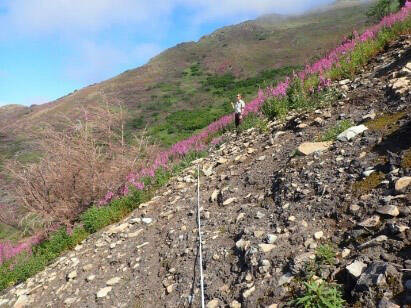By HEIDI HELLING
Kenai National Wildlife Refuge
What can we learn from the Swan Lake Fire that burned over 167,000 acres in 2019? Large areas dominated by black spruce, hot temperatures and extreme drought created perfect conditions for a large-scale wildfire on the Kenai Peninsula, and we now have the opportunity to see how the forest is faring.
Armed with a wealth of vegetation data, taken before the fire, we can compare it to data collected this summer to see how the forest responds three years later.
Fire plays a vital role in the boreal forest landscape. Black spruce, which forms continuous stands in the forests of Southcentral Alaska, is a fire-adapted species that typically burns every 50 to 150 years.
Fire causes black spruce cones to release their seeds. Nourished by nutrient-rich soil, the seedlings will grow, but it will take another 50 years or so to reach maturity. Then the cycle continues with the next wildfire.
The Kenai National Wildlife Refuge staff, Fish and Wildlife Service, Alaska region Fire Ecologist, Lisa Saperstein, and the University of Alaska Anchorage collaborators conducted post-fire successional vegetation sampling to better understand what we can expect to see across the landscape as these plant communities recover from the Swan Lake Fire.
Last June, staff visited Long-Term Ecological Monitoring Program sites via helicopter across the 2019 fire footprint. We were armed with bug nets, a healthy dose of bug dope, snazzy mirror reflective sunglasses, delicious snacks, transect tape and clipboards in tow to document tree regeneration.
The Swan Lake Fire burned hot and severely in some areas within the burn perimeter, as evident along the Sterling Highway by toppled spruce, birch, aspen and cottonwood trees. Little is left for roots to hang onto when hot fires leave only shallow mineral soil behind.
Still, our data collection efforts point toward seeing typical post-fire plant recruitment within forest communities. Seedlings of white and black spruce, birch, aspen and mountain hemlock were present, along with aspen and willow suckers from pre-fire root stocks.
Additionally, the early post-fire colonizers, such as the familiar fireweed, became more visible as the summer wore on. Folks who live or visit the Kenai Peninsula all enjoyed the spectacular large-scale bloom of the vibrant magenta-colored blanket that spread across the landscape this late summer.
Our forests are returning, but yet to be determined is whether future mature forest plant communities will differ in any way from those which followed fire in the past. If so, what implications might that have for wildlife on the Kenai National Wildlife Refuge?
An interesting and potentially less studied trajectory for one of Kenai Peninsula’s iconic plant communities lies in the alpine. Alpine tundra has been documented to burn rarely in Alaska and may take 100 years to recover, or twice as long as the black spruce forests.
The burn intensity in the alpine tundra, such as areas accessible via the locally beloved Skyline Trail, was observed as bare rock, mineral soil and the orange-red fire moss that thrives on heavily burned landscapes. With the vegetation removed, one year later, these steep slopes were actively eroding.
In 2021, two years after the fire event, we again collected vegetation composition data in the alpine tundra. Surveys along these slopes indicated still minimal recruitment during this post-fire time period.
We found the mineral soil left by the blaze provided a clean slate for fireweed and grass seeds to begin taking hold after wind currents drifted seeds in from nearby terrain. Until plants recolonize these steep slopes more completely, they will remain susceptible to erosion.
Will the alpine tundra recover? If so, will it take a century to do so? And, what if additional fires reburn these disturbed areas during the recovery time? Should we expect these alpine areas will convert to the grass-forb meadows, the habitat we typically see at lower elevations? What may this imply for wildlife and invertebrate populations that frequent the higher elevation terrain?
These are important questions projects like this hope to answer to better prepare for environmental changes driven by a changing climate system, including a predicted increase in fire frequencies on the landscape.
Heidi Helling is a Seasonal Biological Science Technician for Kenai National Wildlife Refuge for the 2021 summer season. Find more Refuge Notebook articles (1999–present) at https://www.fws.gov/refuge/Kenai/community/refuge_notebook.html.


